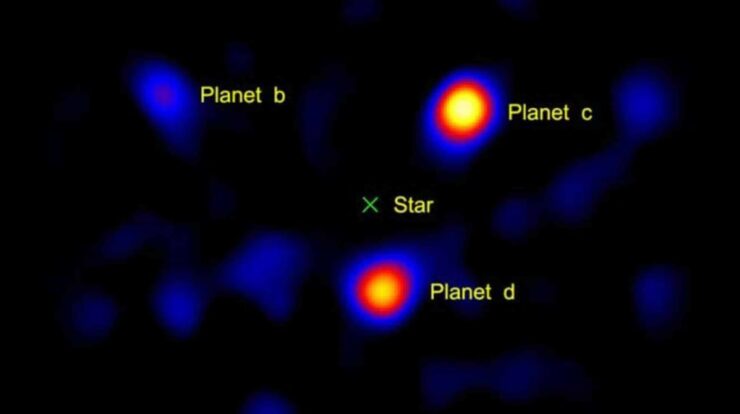
An amazing new video condenses over ten years of space observations into mere seconds, showcasing the mesmerizing movement of far-off planets. This animation was crafted by an astrophysicist.
Jason Wang
from
Northwestern University
features four large exoplanets circling the youthful star HR 8799.
A Giant Step Forward in Depicting Extraterrestrial Planets
Published by
Space.com
, this video relies on findings observed over twelve years utilizing the
W. M. Keck Observatory
In Hawaii, monitoring the movement of celestial bodies beyond our solar system.
solar system
It is not an easy task. The four
exoplanets
orbiting
HR 8799
are enormous—each one larger than
Jupiter
—yet they’re extremely far away, situated approximately
133 light-years
away in the
Pegasus constellation
.
Using advanced
adaptive optics
and a
coronagraph
Researchers managed to eliminate the overwhelming brightness from the host star, enabling the faint glow of these far-off “fireflies” to become discernible in a clear arrangement. This equipment was essential for creating the video and presenting the orbital paths in a manner easily grasped by human vision.
The newly released animation builds upon a previous version that only spanned seven years. With five more years of data, the orbits now appear even smoother, offering an updated look at how these massive bodies dance around their sun-like star in a cosmic slow waltz.
Why Is HR 8799 So Unique?
HR 8799
it is more than just another star. With a mass 1.5 times that of the Sun,
five times more luminous
, it’s both massive and young. With an estimated age of just
30 million years
, it’s a cosmic infant compared to our
4.5-billion-year-old Sun
.
Its youth is one of the reasons scientists were able to detect and study its planets. Young gas giants like those around
HR 8799
are still hot and glowing from the heat of their formation, making them much easier to spot in infrared light. That’s why HR 8799 was the
first star system ever to have its exoplanets directly imaged
, a landmark achieved in
2008
.
The system includes at least four planets—each more massive than
Jupiter
—with orbital periods that range from
45 years
for the closest planet to a staggering
500 years
for the farthest.
These are real images of exoplanets. Four super-Jupiters, imaged 10 times over 12 years around a star 133 lightyears away.
by
u/Neaterntal
in
spaceporn
Why The Timelapse Matters
Although the animation doesn’t provide fresh scientific data, it serves a crucial function in
science communication
As Jason Wang states, “Scientifically, there’s nothing to gain from viewing orbital systems through a time-lapse video, yet it aids others in understanding what we’re investigating.”
“It’s challenging to convey the subtleties of science through words alone. However, demonstrating science in practice assists others in grasping its significance,” he remarked.
Representing events that span hundreds of years in real-time aids in connecting intricate astrophysical information with human comprehension. This process transforms sophisticated celestial movements into a more accessible and lyrical encounter. Additionally, for scientists, this serves as a compelling teaching aid.
The Extended Quest for Discovering Planets
Studying
exoplanetary systems
Like with HR 8799, this is a slow and patient process. Researchers depend on years of observations to verify orbital trajectories, planetary sizes, and the interactions among cosmic objects.
In contrast to short-term missions or satellite flybys, monitoring planets as they orbit necessitates
long-term commitment
, frequently within the course of
multiple scientific careers
In this instance, 12 years of data were condensed into a 4-second video, capturing the continuous efforts of astronomers monitoring celestial bodies as they move across vast distances.
This serves as a reminder that space science isn’t just about impressive rockets and rapid advancements. A significant part of this field involves the steady collection of information over time.
pixel by pixel
, night after night.
Enjoyed this article?
Sign up for our complimentary email newsletter.
For captivating tales, special material, and up-to-date information.
To read more stories like this, check out
Dailyexe
.





